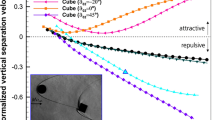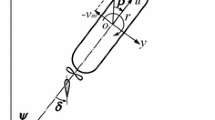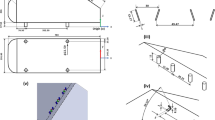Abstract
The research described in this paper was carried out to determine the hydrodynamic forces on the multi-hull tunnel vessel in steady motion. The hull form of vessel is fairly generated by the tunnel hull form generator code using the non-uniform rational B-Spline method. Then, the hydrodynamics simulation is carried out based on finite volume discretization method using volume of fluid model to consider free surface between water and air phases around the vessel. A dynamic mesh restructuring method is applied for grid generation regarding to the heave and pitch motions of vessel in each time step. The calculations of the center of gravity arising, trim angle, pressure, resistance and effective power are studied at various vessel’s speeds. The resistance plot versus velocity has an increasing trend having a hump velocity while the power curve shows a linear-like changes respect to speed increasing. Pressure calculations show that the ratio of hydrostatic pressure to total pressure is decreased at the end point of keel from 100 to 1 % as velocity increases from 5 to 20 m/s. The proposed numerical algorithm is a promising method for hydrodynamic analyses of wide-ranging high speed vessel types, particularly tunnel vessels.


















Similar content being viewed by others
Abbreviations
- \( \vec{a} \) :
-
Linear acceleration vector of mass cent
- F V :
-
Volume Froude number
- g :
-
Gravity acceleration
- I G :
-
Moment inertia matrix of vessel
- k i :
-
Knot vector values
- m :
-
Mass of vessel
- n + 1:
-
Number of control points
- N i,q (k):
-
B-Spline basis functions
- p :
-
Static pressure
- P i :
-
Control point values
- q :
-
Order of NURBS curve
- r + 1:
-
Size of knot vectors
- u′:
-
Random fluctuation linear velocity in x direction
- \( \bar{u} \) :
-
Time average linear velocity in x direction
- u, v, w :
-
Linear velocity in x, y, z direction
- U :
-
Linear vector of velocity
- V S :
-
Velocity of vessel
- W i :
-
Control point weights
- α :
-
Angle between keel and stagnation line
- \( \vec{\alpha } \) :
-
Rotational acceleration vector of mass center
- β :
-
Deadrise angle
- θ :
-
Angle between keel and whisker spray
- λ :
-
Volume fraction of air in cell
- \( \nabla \) :
-
Volume displacement of vessel
- μ w , μ a :
-
Dynamics viscosity of water and air
- ρ w , ρ a :
-
Mass density of water and air
- \( \sum {\vec{F}} \) :
-
Total force vector of mass center
- \( \sum {\vec{M}_{G} } \) :
-
Total moment vector about mass center
- τ :
-
Trim angle
- \( \vec{\omega } \) :
-
Rotational velocity vector of mass center
- BEM:
-
Boundary element method
- LCG:
-
Longitudinal center of gravity
- VCG:
-
Vertical center of gravity
- CFD:
-
Computational fluid dynamic
- DOF:
-
Degrees of freedom
- FVM:
-
Finite volume method
- NURBS:
-
Non uniform rational B-Spline
- RANS:
-
Reynolds-averaged Navier–Stokes
- THFG:
-
tunnel hull form generator
- UDF:
-
User define function
- VOF:
-
Volume of fluid
References
Hinatsu M (2004) Fourier NUBS method to express ship hull form. J Mar Sci Technol 9:43–49
Kim H-C, Nowaki H (2005) Parametric design of complex hull forms. Ship Technol 9(1):47–63
Mancuso A (2006) Parametric design of sailing hull shapes. Ocean Eng 33(2):234–246
Sarioz E (2006) An optimization approach for fairing of ship hull forms. Ocean Eng 33(13):2105–2118
Perez F, Suarez JA (2007) Quasi-developable B-Spline surfaces in ship hull design. Comput Aided Des 39:853–862
Wang H, Zou Z-J (2008) Geometry modeling of ship hull based on non-uniform B-Spline. J Shanghai Jiao Tong Univ 13(2):189–192
Perez FL, Clemente JA (2008) Parametric generation, modeling, and fairing of simple hull lines with the use of non-uniform rational B-Spline surfaces. J Ship Res 52(1):1–15
Ventura M, Guedes Soares C (2012) Surface intersection in geometric modeling of ship hulls. J Mar Sci Technol 17(1):114–124
Calkins D, Schachter RD, Oliveira LT (2001) An automated computational method for planing hull form definition in concept design. Ocean Eng 28(3):297–327
Ghassabzadeh M, Ghassemi H (2013) An innovative method for parametric design of planing tunnel vessel hull form. Ocean Eng 60(4):14–30
Yousefi R, Shafaghat R, Shakeri M (2013) Hydrodynamic analysis techniques for high-speed planing hulls. Appl Ocean Res 42:105–113
Savitsky D (1964) Hydrodynamic design of planing hulls. Mar Technol 1(1):71–95
Savitsky D, Brown PW (1976) Procedures for hydrodynamic evaluation of planing hulls in smooth and rough water. Mar Technol 13(4):381–400
Savitsky D, Delorme MF, Datla R (2007) Inclusion of whisker spray drag in performance prediction method for high-speed planing hulls. Mar Technol 44(1):35–56
Savitsky D, Morabito M (2010) Surface wave contours associated with the forebody wake of stepped planing hulls. Mar Technol 47(1):1–16
Ghassemi H, Ghiasi M (2008) A combined method for the hydrodynamic characteristics of planing crafts. Ocean Eng 35:310–322
Ghassemi H, Su YM (2008) Determining the hydrodynamic forces on a planing hull in steady motion. J Mar Sci Appl 7:147–156
Kohansal AR, Ghassemi H (2010) A numerical modeling of hydrodynamic characteristics of various planing hull forms. Ocean Eng 37:498–510
Sun H, Faltinsen OM (2012) Hydrodynamic forces on a semi-displacement ship at high speed. Appl Ocean Res 48:68–77
Hirt CW, Nichols BD (1981) Volume of fluid (VOF) method for the dynamics of free boundaries. J Comput Phys 39:201–205
Panahi R, Jahanbakhsh E, Seif MS (2009) Towards simulation of 3D nonlinear high-speed vessels motion. Ocean Eng 36:256–265
Su Y, Chen Q, Shen Ch, Lu W (2012) Numerical simulation of a planing vessel at high speed. J Mar Sci Appl 11:178–183
Subramanian AV, Subramanyam PVV, Sulficker AN (2007) Pressure and drag influences due to tunnels in high-speed planing craft. Int Shipbuild Prog 54(25–44):25
Subramanian AV, Subramanyam PVV (2005) Effect of tunnel on the resistance of high speed planing craft J Nav Archit Mar Eng
Millward A (2004) The effect of channel width and depth on the resistance of a high speed hull, Int. Shipbuilding Progress, 51, No. 4, pp.377–394
Piegl L, Tiller W (1997) The NURBS book. Springer, Berlin
FLUENT Inc., 2006, Fluent 6.3 user’s guide, www.fluent.com
Acknowledgments
This research was supported by High Performance Computing Research Center (HPCRC) at Amirkabir University of Technology, which is acknowledged. Authors would like to thank the reviewers for their valuable comments.
Author information
Authors and Affiliations
Corresponding author
Additional information
Technical Editor: Francisco Ricardo Cunha.
Rights and permissions
About this article
Cite this article
Ghassabzadeh, M., Ghassemi, H. Determining of the hydrodynamic forces on the multi-hull tunnel vessel in steady motion. J Braz. Soc. Mech. Sci. Eng. 36, 697–708 (2014). https://doi.org/10.1007/s40430-013-0110-2
Received:
Accepted:
Published:
Issue Date:
DOI: https://doi.org/10.1007/s40430-013-0110-2




